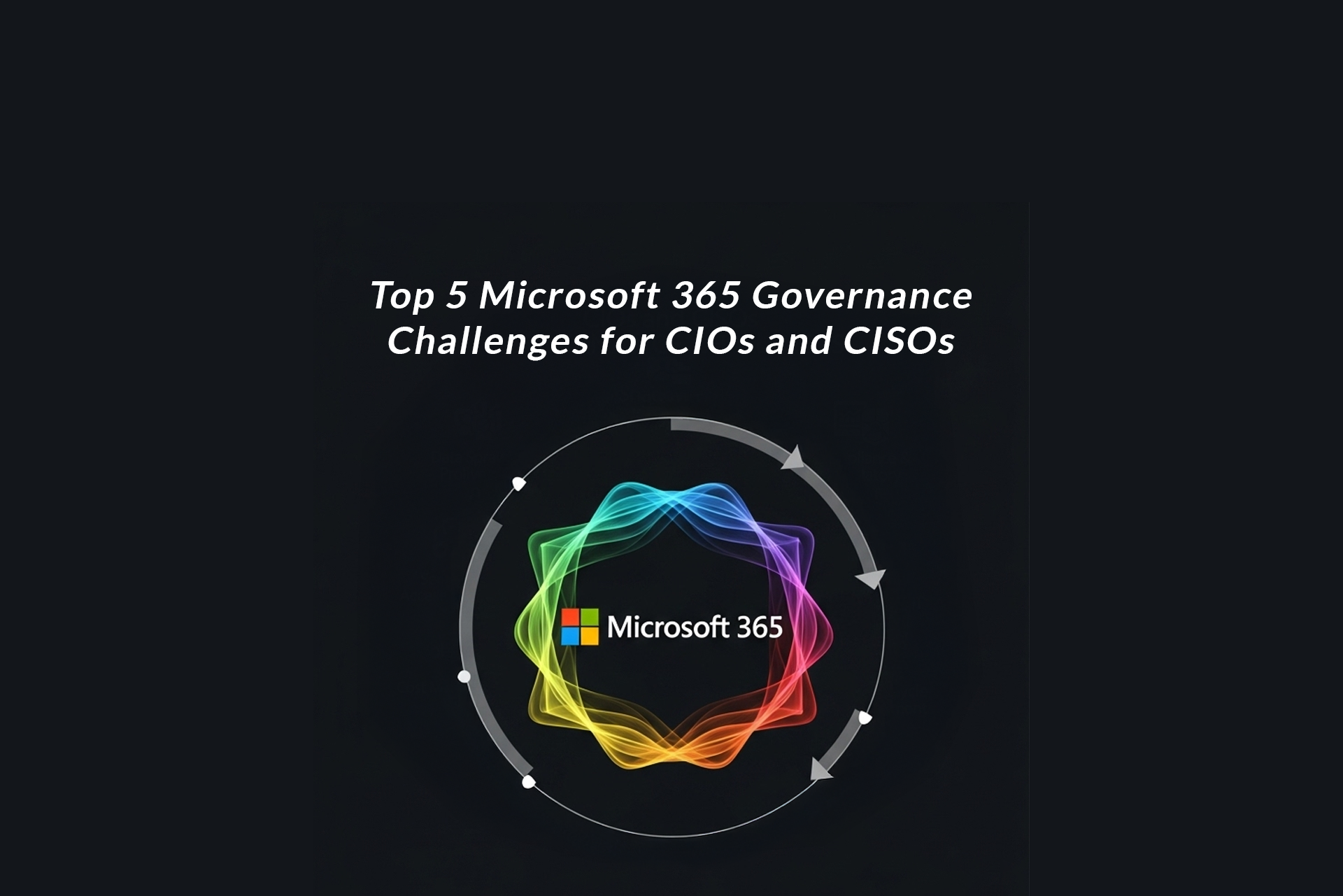
Top 5 Microsoft 365 Governance Challenges for CIOs and CISOs
Top 5 Microsoft 365 Governance Challenges for CIOs and CISOs
And How to Solve Them Without Slowing Down Collaboration
Microsoft 365 has become the backbone of enterprise collaboration but with its flexibility comes complexity. CIOs and CISOs face a balancing act: enabling seamless teamwork while maintaining airtight governance. Missteps can lead to identity sprawl, oversharing, compliance gaps, and even AI‑driven data exposure. In this article, we break down the five most common governance challenges and share practical strategies to solve them without slowing down collaboration or innovation.
① How Can Enterprises Reduce Guest Sprawl and Identity Risk in Microsoft Entra ID?
The challenge: Guest accounts in Entra ID multiply fast if they are the primary means to grant external user access to the tenant. They create long-lived risk across tenants, especially in large partner ecosystems.
Best practice: Bring Your Own Identity (BYOI) allows secure collaboration without guest accounts. Partners use their own credentials—no guest object in your tenant to manage.
Why it matters: This reduces identity sprawl, aligns with Zero Trust, removes administrative barriers, and tightens governance without user friction.
② What’s the Best Way to Enforce Least Privilege in SharePoint and Teams?
The challenge: Default open sharing and nested permissions result in excessive access and undermines Zero Trust principles. Manual cleanup is rare and inconsistent at enterprise scale.
Best practice: Apply content-level governance using Microsoft Information Protection (MIP) labels to set view/edit/download restrictions, expiration, watermarking—inside native Microsoft 365 tools.
Why it matters: You enforce least privilege without retraining users or slowing down collaboration.
③ How Do You Prevent Sensitive Files from Leaving Your Microsoft 365 Tenant?
The challenge: Sharing email attachments or copying files to third-party cloud storage requires data to leave theM365 environment—and your control—forever.
Best practice: Share content with external users directly within OneDrive/SharePoint/Teams. Apply native Microsoft controls (MFA, DLP, Conditional Access) and share via branded domains.
Why it matters: You maintain continuous oversight and auditability; control versioning; enforce policy; and reduce regulatory risk.
④ How Can Enterprises Apply Consistent External Sharing Policies Across All Tenants?
The challenge: Microsoft 365 settings are spread across 5 admin centers and 50+ controls. Policy enforcement canvary wildly between teams and partners.
Best practice: Standardize governance workflows with user-initiated policy enforcement.Empower data owners to determine how external access is requested, granted, reviewed, and revoked.
Why it matters: You move from ad-hoc governance to a consistent, scalable framework that spans your entire ecosystem that allows flexible user-enabled controls to streamline secure sharing.
⑤ How Do You Make Microsoft Copilot Safe to Use in Regulated Environments?
The challenge: Copilot can inadvertently surface mis-permissioned or overshared content. Without enterprise-wide governance and context-based enforcement, AI increases data exposure risks.
Best practice: Enforce Zero Trust access and data classification before enabling AI. Align policy with MIP labels, audit trails, and data-level controls.
Why it matters: You avoid compliance issues by preventing unauthorized data access while enabling secure, AI-driven productivity.
➙ Bonus: Why Branded Sharing Links Improve Trust and Deliverability
Generic OneDrive/SharePoint links can trigger firewalls or spam filters. Branded links hosted on your own domain improve trust and visibility, especially in finance, healthcare, and government.
What CIOs and CISOs Should Do Next
• Eliminate guest sprawl with BYOI
• Enforce content-level permissions using MIP
• Keep data in-tenant
• Standardize external governance
• Enforce least privilege before enabling AI tools like Copilot
Want to operationalize secure collaboration in Microsoft 365?
Learn how enterprises are weaving governance into collaborative workflows without slowing down productivity or innovation. Join the Hub and connect with other CIOs and CISOs tackling Microsoft 365 governance challenges. Share your insights, ask questions, and learn from peers who are shaping secure collaboration strategies.
👉 Contact the Hub today to join the discussion.
Top 5 Microsoft 365 Governance Challenges for CIOs and CISOs
And How to Solve Them Without Slowing Down Collaboration
Microsoft 365 has become the backbone of enterprise collaboration but with its flexibility comes complexity. CIOs and CISOs face a balancing act: enabling seamless teamwork while maintaining airtight governance. Missteps can lead to identity sprawl, oversharing, compliance gaps, and even AI‑driven data exposure. In this article, we break down the five most common governance challenges and share practical strategies to solve them without slowing down collaboration or innovation.
① How Can Enterprises Reduce Guest Sprawl and Identity Risk in Microsoft Entra ID?
The challenge: Guest accounts in Entra ID multiply fast if they are the primary means to grant external user access to the tenant. They create long-lived risk across tenants, especially in large partner ecosystems.
Best practice: Bring Your Own Identity (BYOI) allows secure collaboration without guest accounts. Partners use their own credentials—no guest object in your tenant to manage.
Why it matters: This reduces identity sprawl, aligns with Zero Trust, removes administrative barriers, and tightens governance without user friction.
② What’s the Best Way to Enforce Least Privilege in SharePoint and Teams?
The challenge: Default open sharing and nested permissions result in excessive access and undermines Zero Trust principles. Manual cleanup is rare and inconsistent at enterprise scale.
Best practice: Apply content-level governance using Microsoft Information Protection (MIP) labels to set view/edit/download restrictions, expiration, watermarking—inside native Microsoft 365 tools.
Why it matters: You enforce least privilege without retraining users or slowing down collaboration.
③ How Do You Prevent Sensitive Files from Leaving Your Microsoft 365 Tenant?
The challenge: Sharing email attachments or copying files to third-party cloud storage requires data to leave theM365 environment—and your control—forever.
Best practice: Share content with external users directly within OneDrive/SharePoint/Teams. Apply native Microsoft controls (MFA, DLP, Conditional Access) and share via branded domains.
Why it matters: You maintain continuous oversight and auditability; control versioning; enforce policy; and reduce regulatory risk.
④ How Can Enterprises Apply Consistent External Sharing Policies Across All Tenants?
The challenge: Microsoft 365 settings are spread across 5 admin centers and 50+ controls. Policy enforcement canvary wildly between teams and partners.
Best practice: Standardize governance workflows with user-initiated policy enforcement.Empower data owners to determine how external access is requested, granted, reviewed, and revoked.
Why it matters: You move from ad-hoc governance to a consistent, scalable framework that spans your entire ecosystem that allows flexible user-enabled controls to streamline secure sharing.
⑤ How Do You Make Microsoft Copilot Safe to Use in Regulated Environments?
The challenge: Copilot can inadvertently surface mis-permissioned or overshared content. Without enterprise-wide governance and context-based enforcement, AI increases data exposure risks.
Best practice: Enforce Zero Trust access and data classification before enabling AI. Align policy with MIP labels, audit trails, and data-level controls.
Why it matters: You avoid compliance issues by preventing unauthorized data access while enabling secure, AI-driven productivity.
➙ Bonus: Why Branded Sharing Links Improve Trust and Deliverability
Generic OneDrive/SharePoint links can trigger firewalls or spam filters. Branded links hosted on your own domain improve trust and visibility, especially in finance, healthcare, and government.
What CIOs and CISOs Should Do Next
• Eliminate guest sprawl with BYOI
• Enforce content-level permissions using MIP
• Keep data in-tenant
• Standardize external governance
• Enforce least privilege before enabling AI tools like Copilot
Want to operationalize secure collaboration in Microsoft 365?
Learn how enterprises are weaving governance into collaborative workflows without slowing down productivity or innovation. Join the Hub and connect with other CIOs and CISOs tackling Microsoft 365 governance challenges. Share your insights, ask questions, and learn from peers who are shaping secure collaboration strategies.
👉 Contact the Hub today to join the discussion.
FAQ
How can CIOs ensure compliance and audit readiness in Microsoft 365?
Balancing collaboration speed with strong governance is the top challenge. Features like Teams/SharePoint external sharing can create oversharing and audit gaps if unmanaged. Pairing Microsoft Purview with a guest-less external collaboration layer like eSHARE keeps data in-tenant, applies existing controls, and gives CIOs/CISOs the visibility they need without slowing work.
What is the biggest Microsoft 365 governance challenge for CIOs and CISOs today?
Balancing collaboration speed with strong governance is the top challenge. Features like Teams/SharePoint external sharing can create oversharing and audit gaps if unmanaged. Pairing Microsoft Purview with a guest-less external collaboration layer like eSHARE keeps data in-tenant, applies existing controls, and gives CIOs/CISOs the visibility they need without slowing work.
How do organizations manage Microsoft 365 guest account sprawl?
Balancing collaboration speed with strong governance is the top challenge. Features like Teams/SharePoint external sharing can create oversharing and audit gaps if unmanaged. Pairing Microsoft Purview with a guest-less external collaboration layer like eSHARE keeps data in-tenant, applies existing controls, and gives CIOs/CISOs the visibility they need without slowing work.







